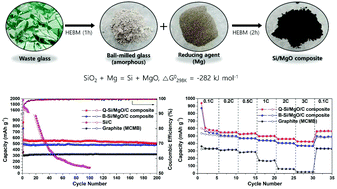Facile conversion of waste glass into Li storage materials†
Abstract
The development of recycling technology for waste glass is crucial because numerous types of waste glass are generated daily. To recycle waste glass, we developed a facile conversion technology for turning waste glass into high-capacity Li storage materials. Nanostructured Si-based composites were synthesized by a simple solid-state synthesis method using three waste glass types: soda-lime, borosilicate, and quartz. Firstly, various waste glass types were mechanically crushed into powders, after which they were reduced into Si using a Mg reducing agent powder by a simple high-energy ball-milling (BM) process, forming composites comprising Si and MgO (Si/MgO). The potentials of these composites for use as Li-ion battery (LIB) anodes were investigated. To further enhance the electrochemical performances of the Si/MgO composites, amorphous C-modified composites (Si/MgO/C) were simply prepared by further high-energy BM processing for 0.5 h. The Si/MgO/C composites comprised well-dispersed nanocrystalline Si, Li-inactive MgO, and various Li-inactive oxides from the additives used for glass formation within the buffering amorphous C matrices. The Si/MgO/C composites prepared by the facile recycling of waste borosilicate and quartz glasses exhibited high reversible capacities of 487 and 549 mA h g−1 and stable capacity retentions of approximately 100% and 93% after 200 cycles, respectively.



 Please wait while we load your content...
Please wait while we load your content...